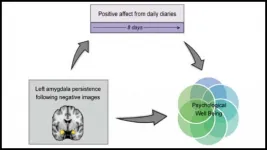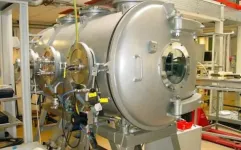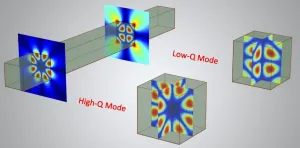(Press-News.org) For something we spend one-third of our lives doing, we still understand remarkably little about how sleep works -- for example, why can some people sleep deeply through any disturbance, while others regularly toss and turn for hours each night? And why do we all seem to need a different amount of sleep to feel rested?
For decades, scientists have looked to the behavior of the brain's neurons to understand the nature of slumber. Now, though, researchers at UC San Francisco have confirmed that a different type of brain cell that has received far less study -- astrocytes, named for their star-like shape -- can influence how long and how deeply animals sleep. The findings could open new avenues for exploring sleep disorder therapies and help scientists better understand brain diseases linked to sleep disturbances, like Alzheimer's and other dementias, the authors say.
"This is the first example where someone did an acute and fast manipulation of astrocytes and showed that it was able to actually affect sleep," said Trisha Vaidyanathan, the study's first author and a neuroscience graduate student at UCSF. "That positions astrocytes as an active player in sleep. It's really exciting."
When we're awake, our brains are a Babel of disjointed neuronal voices chattering amongst themselves to allow us to work through life's daily tasks. But when we sleep, the voices of signaling neurons meld into a unified chorus of bursts, which neuroscientists call slow-wave activity. Recent research had suggested that astrocytes, not just neurons, may help trigger this switch.
Comprising an estimated 25 to 30 percent of brain cells, astrocytes are a type of so-called glial cell that blanket the brain with countless bushy tendrils. This coverage allows each individual astrocyte to listen in on tens of thousands of synapses, the sites of communication between neurons. The plentiful cells connect to each other through specialized channels, which researchers think may allow astrocytes located across the brain to function as one unified network. The hyperconnected and ubiquitous astrocytes might be able to drive synchronized signaling in neurons, as suggested by the new study, published March 17, 2021, in eLife.
"This could give us new insights not only into sleep but into diseases in which sleep dysregulation is a symptom," said study senior author Kira Poskanzer, PhD, an assistant professor in the UCSF Department of Biochemistry and Biophysics. "Maybe some diseases are affecting astrocytes in a way we hadn't thought about before."
Poskanzer and her team tracked changes in slow-wave activity in the brains of mice while manipulating astrocytes using a drug that can switch the cells on in genetically engineered animals. Slow-wave activity can be represented in much the same way as vibrations from an earthquake are scratched out on a seismograph. When the brain's awake, the resulting traces are typically a dense scribble of short and jerky motions. But when slow-wave activity kicks in during certain stages of sleep, the signal slows, lazily looping up and down to create a trace with deep valleys and high peaks. The researchers found that firing up astrocytes led to more slow-wave activity -- and thus sleep -- in the mice.
But the team wanted to examine astrocytes' role in finer detail, asking how these cells exert their influence and what aspects of sleep they manage.
In addition to the specialized junctions that join neighboring astrocytes, these cells are studded with a variety of receptor molecules that allow them to respond to signals coming from neurons and other types of cells around them. In the study the team hijacked two of these molecules -- called the Gi and Gq receptors -- and found that they each appeared to control a distinct aspect of sleep. Activating Gq receptors made animals sleep longer, but not more deeply, according to slow-wave measurements, while engaging Gi receptors put into a much deeper slumber without affecting sleep duration.
"Depth and duration are aspects of sleep that often get glossed over and lumped together even in neuroscience," said Vaidyanathan. "But picking apart these different aspects and how they're regulated is going to be important down the line for creating more specific sleep treatments."
The team also found that astrocyte activity has long reach across the brain: triggering astrocytes in one part of the cortex could affect neuronal behavior at a distant point. The researchers are eager to look further into the extent of this influence and to continue to study how different astrocytic receptors work together to impact sleep, Poskanzer says.
"What have people been missing because they're ignoring this group of cells?" she wondered. "The questions that haven't been answered thus far in sleep neurobiology -- maybe they haven't been answered because we haven't been looking in the right places."
INFORMATION:
Authors: Kira Poskanzer is the senior and corresponding author, and Trisha Vaidyanathan is the study's first author. Other authors were Max Collard, Sae Yokoyama and Michael E. Reitman, all of UCSF.
Funding: The research was supported by the National Institutes of Health (R01NS099254, R01MH121446, R21DA048497), the National Science Foundation (CAREER 1942360), and the UCSF Genentech Fellowship.
Disclosures: The authors declare no competing interests.
About UCSF: The University of California, San Francisco (UCSF) is exclusively focused on the health sciences and is dedicated to promoting health worldwide through advanced biomedical research, graduate-level education in the life sciences and health professions, and excellence in patient care. UCSF Health, which serves as UCSF's primary academic medical center, includes top-ranked specialty hospitals and other clinical programs, and has affiliations throughout the Bay Area. Learn more at ucsf.edu, or see our Fact Sheet.
Follow UCSF
ucsf.edu | Facebook.com/ucsf | YouTube.com/ucsf
A large study of brain MRI scans from 11,679 nine- and ten-year-old children reviewed by UC San Francisco neuroradiologists identified potentially life-threatening conditions in 1 in 500 children, and more minor but possibly clinically significant brain abnormalities in 1 out of 25 children.
The results provide the best estimates to date of the true incidence of various structural abnormalities in the developing brain, and raise the question of whether all MRI brain imaging obtained during research studies should be reviewed by board-certified radiologists, as was done in this study, in the hopes of saving lives and alerting participants to incidental findings that ought to be medically evaluated.
One ...
How the amygdala responds to viewing negative and subsequent neutral stimuli may impact our daily mood, according to new research published in JNeurosci.
The amygdala evaluates the environment to find potential threats. If a threat does appear, the amygdala can stay active and respond to new stimuli like they are threatening too. This is helpful when you are in a dangerous situation, but less so when spilling your coffee in the morning keeps you on edge for the rest of the day.
In a recent study, Puccetti et al. examined data collected from the "Midlife ...
MINNEAPOLIS/ST.PAUL (03/22/2021) -- New research from the University of Minnesota Medical School suggests that disease-driving B cells, a white blood cell, play a role in the development of non-alcoholic fatty liver disease (NAFLD) - the most common chronic liver condition in the U.S. Their findings could lead to targeted therapies for NAFLD, which currently affects a quarter of the nation and has no FDA-approved treatments.
After noticing that patients with the disease showed a large number of inflammatory B cells in their livers, Xavier Revelo, PhD, an assistant professor in the Department of Integrative Biology and Physiology and senior author, began studying B cells in NAFLD.
"This disease is increasing in prevalence ...
Although Tuberculosis, or TB, killed nearly as many people as COVID-19 (approx. 1.8 million) in 2020, it did not receive as much media and public attention. The pandemic has proven that transmissible infection is indeed a global issue. TB remains a serious public health concern in Ireland, particularly with the presence of multi-drug resistant types and the numbers of complex cases here continuing to rise, with cases numbering over 300 annually.
Science tells us that iron is crucial for daily human function, but it is also an essential element for the survival of ...
Batteries charge and recharge--apparently all thanks to a perfect interplay of electrode material and electrolyte. However, for ideal battery function, the solid electrolyte interphase (SEI) plays a crucial role. Materials scientists have now studied nucleation and growth of this layer in atomic detail. According to the study published in the journal Angewandte Chemie, the properties of anions and solvent molecules need to be well balanced.
In lithium-ion batteries, the SEI forms at the beginning of the first charging process, when a potential is applied. Elements from the electrolyte deposit on the graphite electrode and form a coating that soon ...
Antibiotics have revolutionized the field of medicine by making it possible to treat most known microbial diseases today. However, their uncontrolled usage has led to the major global problem of antibiotic resistance. As we continue to exploit antibiotics, sometimes at doses much higher than needed, disease-causing bacteria are rapidly evolving defense strategies to evade them. These drug-resistant bacteria, also known as "superbugs," cause severe infections that are difficult to treat and can eventually be fatal.
Methicillin-resistant Staphylococcus aureus (MRSA), a particularly vicious group of superbugs that have developed resistance to the antibiotic methicillin, is a major cause of hospital-acquired infections. Accurate and timely diagnosis ...
Boulder, Colo., USA: Beneath the cold, dark depths of the Arctic ocean sit vast reserves of methane. These stores rest in a delicate balance, stable as a solid called methane hydrates, at very specific pressures and temperatures. If that balance gets tipped, the methane can get released into the water above and eventually make its way to the atmosphere. In its gaseous form, methane is one of the most potent greenhouse gases, warming the Earth about 30 times more efficiently than carbon dioxide. Understanding possible sources of atmospheric methane is critical for accurately predicting future climate change.
In the Arctic Ocean today, ice sheets exert pressure on the ground below them. That pressure diffuses ...
Screenings for breast cancer and colon cancer dropped dramatically during the early months of the coronavirus pandemic, but use of the procedures returned to near-normal levels by the end of July 2020, according to a new study.
Analyzing insurance claims from more than 6 million Americans with private health coverage, researchers found that mammography rates among women aged 45 to 64 declined by 96% during March and April 2020 as compared to January and February.
Similarly, the weekly rate of colorectal cancer screenings among adults aged 45 to 64 and older declined by 95% during the period.
By the end of July 2020, however, the rate of mammograms among women had rebounded and was slightly higher than it had been before the pandemic was declared. The rate of colonoscopies also rebounded, ...
Researchers at Trinity College Dublin have been shedding light on the enigmatic "spiders from Mars", providing the first physical evidence that these unique features on the planet's surface can be formed by the sublimation of CO2 ice.
Spiders, more formally referred to as araneiforms, are strange-looking negative topography radial systems of dendritic troughs; patterns that resemble branches of a tree or fork lightning. These features, which are not found on Earth, are believed to be carved into the Martian surface by dry ice changing directly from solid to gas (sublimating) in the spring. Unlike Earth, Mars' atmosphere comprises mainly of CO2 and as temperatures decrease in winter, this deposits onto the surface as CO2 ...
Optical resonators provide the foundation of modern photonics and optics. Thanks to its extreme energy confinement, the high-Q-factor optical resonator optimizes light-matter interaction and photonic device performance by enabling low-threshold laser and enhanced nonlinear harmonic generation.
Two typical structures, the photonic crystal cavity and the whispering gallery cavity, are frequently used to obtain extremely high-Q factors. However, these structures may require dimensions that are comparable to--or several times larger than--the operating wavelength. Whether there is a general way to find out all high-Q modes in a dielectric ...



